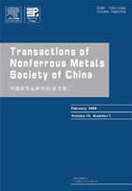Effect of cross-section change on microstructure and properties of quasi β forging of Ti-55511 alloy large-scale components
(1. College of Materials Science and Engineering, Hunan University, Changsha 410082, China;
2. Deyang Wanhang Die Forging Co., Ltd., China National Erzhong Group Co., Deyang 618013, China;
3. Institute of Advanced Wear & Corrosion Resistant and Functional Materials, College of Chemistry and Materials Science, Jinan University, Guangzhou 510632, China)
2. Deyang Wanhang Die Forging Co., Ltd., China National Erzhong Group Co., Deyang 618013, China;
3. Institute of Advanced Wear & Corrosion Resistant and Functional Materials, College of Chemistry and Materials Science, Jinan University, Guangzhou 510632, China)
Abstract: The microstructure and mechanical properties of the Ti-5Al-5Mo-5V-1Cr-1Fe (Ti-55511) alloy under different strains were investigated through the design of step-shaped die forging. The results indicate that continuous dynamic recrystallization (CDRX) and discontinuous dynamic recrystallization (DDRX) occur in the high strain region. The orientation of the grains produced by CDRX is random and does not weaken the fiber texture. á100?-oriented grains expand gradually with increasing strain, thereby enhancing the strength of {100} texture. Significant anisotropic mechanical properties are observed in the large strain region and analyzed through in-situ tensile experiments. When the loading direction is parallel to the longitudinal (L) direction, strain concentration is observed near the dynamically recrystallized (DRXed) grains and inside grains oriented along á100?, leading to crack initiation. Furthermore, the small angle between the loading direction and the c-axis hinders the activation of prismatic and basal slip, thereby enhancing the strength. When the loading direction is parallel to the short transverse (ST) direction, cracks are initiated not only within grains oriented along á100?, but also at the grain boundaries. Regarding impact toughness, the elongated β grains in the L direction enhance the resistance to crack propagation.
Key words: Ti-5Al-5Mo-5V-1Cr-1Fe alloy; step-shaped die forgings; strain distribution; deformation mechanism; mechanical properties

